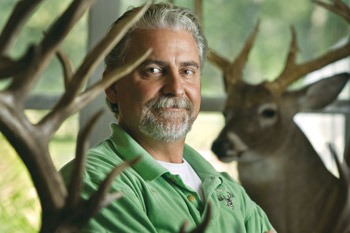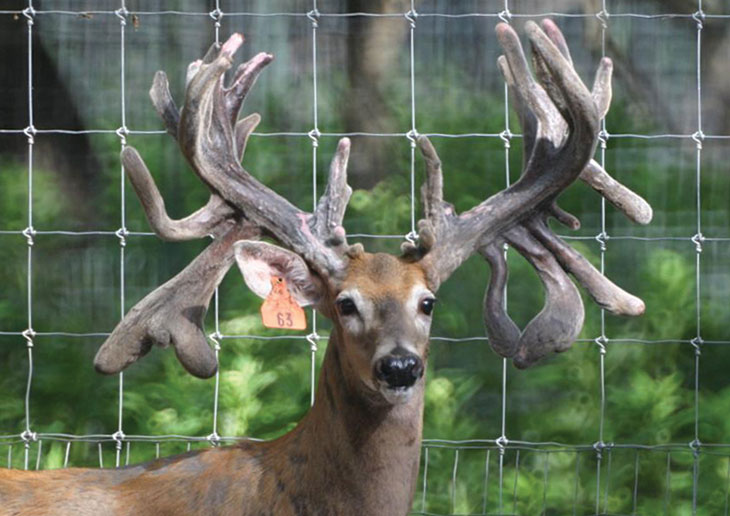THEN & NOW
When Landscapes visited Mustang Creek Ranch in 1999, the whitetail operation boasted a 225 B&C buck, Rocket. This year, owner Bill Grace hopes his best buck will break 300 B&C.
Every year, Bill Grace and his family and staff at Mustang Creek Ranch in central Texas look forward to fall, anxious and excited, like children anticipating Christmas. That’s when they assess the new crop of antlers on Mustang Creek’s large herd of scientifically bred white-tailed bucks.
Each new set of antlers is a surprise, unique like a new baby and unpredictable like spring weather. And each set has the potential to dramatically increase the herd’s value: The bigger the rack, the more a buck and its progeny are worth in the rapidly growing multimillion-dollar deer-breeding industry.

Bill Grace
Photo by Jim Lincoln
"It’s like Christmas every fall, here," says Grace, who’s been breeding whitetails commercially since 1994.
And what a "Christmas" it’s been for him in recent years.
In 2007, as a 4-year-old, Mustang James, his best-known buck, produced an eye-popping rack that scored 298 on the Boone and Crockett (B&C) scoring system, which measures total antler mass and symmetry. To register a buck in the official Boone and Crockett record book, the animal must score at least 170 net for typical and 195 net for nontypical.
Twelve Bucks Over 200 B&C
Currently, 12 of Grace’s homegrown bucks have scores over 200 B&C. And this fall, he expects that his favorite, Mustang Chopper, will top 300 B&C as a 4-year-old.
Bucks like these are rare, however, unless Mother Nature has some help. And at Mustang Creek Ranch, that help comes from the latest reproductive technology — including laparoscopic artificial insemination — plus a whole lot of pampering.
“He’s the only rancher I know that on a sustained yield basis is harvesting a buck to 50 acres.” — Dr. James Kroll
Back in 1992, Grace and his father, James — both lifelong hunters — purchased Mustang Creek Ranch near Salado, Texas, with a goal of offering managed hunts. They high-fenced the rugged 2,500-acre property, introduced several exotic wildlife species and began an intensively managed hunting operation. But whitetails were just a small part of the business at the time.
"When I started, I wanted to be the largest axis deer breeder in Texas," Grace recalls. At one point, he owned 1,000 axis does. "But after a while I realized they weren’t going to pay the bills," he says.
In 1994, Grace switched his focus to whitetails, which showed more profit potential.
To help him bridge the learning gap, he hired Dr. James C. Kroll, director of the Institute for White-Tailed Deer Management Research at Stephen F. Austin State University, as his consulting biologist.
Lessons From Candy-Making
Having worked in the family’s California candy business, Helen Grace Chocolates, Grace recognized the importance of hiring well-qualified people and using high-quality ingredients.
"I think like a candy-maker," he says. "The most important thing is the ingredients. You want to have high production without compromising quality."
At the time, Kroll — nicknamed Dr. Deer — and his university research team were the only Texans using artificial insemination (A.I.) on deer. On Kroll’s advice, Grace adopted A.I. as a way to introduce superior genetics into his herd, thus becoming one of the first commercial deer breeders in North America known to use A.I.
It would become the key to success for Mustang Creek Ranch, which today markets stocker bucks, semen, open and bred does, and breeder bucks.
Over the years, Grace has developed his herd with bloodlines from top bucks, including, most recently, Maxbo, a 374 B&C buck from Pennsylvania. Moreover, all of his does come from 200 B&C sires and dams.
Last year, the ranch bred 30 does using laparoscopic A.I. and 130 does using traditional A.I. This compares with the 40 does that the ranch bred via A.I. in 1996.
Working with Kroll and Champion Genetics, Grace and his staff — which includes a biologist — have fine-tuned their breeding program and established their own high standards for semen motility, whether selling semen or breeding their own deer.
A.I. allows Grace to magnify the superior genetics on his ranch. Through A.I., he has been able to develop detailed pedigrees and collect genetic data for each of the 540 whitetails in his scientific breeder herd — data that is critical to his entire breeding and marketing program.
Also important, A.I. has prevented the introduction of Chronic Wasting Disease to the herd.
Seven Generations Disease-Free
"We have pretty much a closed herd, with up to seven generations disease-free," Grace reports.
To ensure that the deer are handled as gently as possible during vaccination, tattooing, A.I. and other treatments, he built a 5,000-square-foot barn with wedge-shaped pens that funnel from one to another. Financed by Texas Land Bank, his lender since 1992, the barn is air-conditioned and designed to minimize stress on the deer.
Texas Land Bank Helps Out
"Whenever we’ve needed help, Texas Land Bank has been right with us. They understand the farming and ranching business," says Grace, who financed avocado farms with a Land Bank Association in California, before relocating to Texas. He is currently building a new ranch office and hunting lodge with another construction loan from Texas Land Bank.
The lodge will accommodate hunters, who come for trophy or management whitetail hunts, as well as turkey, quail, pheasant, chukar and exotic wildlife hunts. As a bonus, guests can cast for bass and catfish in the picturesque Mustang Creek.
Kroll believes that the combination of breeding and hunting operations factors heavily in the success of Mustang Creek Ranch. "Bill has an integrated approach, and so he is constantly improving his genetics and managing his habitat both for the deer and for the experience of the hunter," Kroll says.
Situated on the northeastern fringe of the Texas Hill Country, Mustang Creek Ranch provides the type of browse, forbs and cactus pear that whitetails enjoy. Grace concentrates on growing buck forage oats and chicory, which have a longer growing season than traditional winter food plots. He doesn’t bother much with summer food plots, although he plans to plant cow peas next summer.
It’s an approach that seems to be working. "He’s the only rancher I know that on a sustained yield basis is harvesting a buck to 50 acres," Kroll says.
With such a variety of wildlife and birdlife on the ranch, including the endangered golden-cheeked warbler, Grace says that raising deer "is a way to keep the land natural and beneficial for all wildlife."
Good Stewardship Pays Off
"I can’t think of anything else we could do with this land that would make it pay," Grace says. "I want to be a good steward of the land and try to make it profitable, so we can keep it like it is."
His wife, Tere, who is involved in marketing for the ranch, agrees. "We want our kids and grandkids to appreciate nature and to come and see animals running free and to see water flowing freely," she says.
As he surveys the terrain and ponders this fall’s antler crop, Grace does not forget to give credit to his mentor. "We owe everything to Dr. Kroll. He is so knowledgeable and so selfless. He has helped us tremendously," he says.
For more information, visit www.whitetailbuck.com.
-Janet Hunter
Advice for Whitetail Buyers
Thinking of purchasing scientifically bred deer to improve your herd? Bill Grace offers this advice:
- Buy from a well-known breeder, who is considered honest and reputable.
- Buy from a disease-free herd. Find out the herd’s Chronic Wasting Disease–free anniversary.
- Buy locally. The deer will adjust better to the climate and forage conditions on your ranch.
- Have a contract, stipulating the conditions of sale for both the buyer and seller.
- If you plan to buy at an auction, do your research first and set your price limit.
Deer Breeding
Growing by Leaps and Bounds
Early on the morning of May 3 this year, 160 people — many of them new to deer breeding — arrived at the gates of Mustang Creek Ranch in central Texas. They came from across Texas and from as far away as Louisiana and Mexico for one purpose — to learn about white-tailed deer management.

Mustang James, a 298 B&C buck, exhibits eight drop tines.
Photo by Bill Grace
The event was the third annual Whitetail Workshop and Intro to A.I. School, led primarily by Dr. James Kroll, director of the Institute for White-tailed Deer Management and Research Center at Stephen F. Austin State University.
According to Bill Grace, owner of Mustang Creek Ranch and host of the workshop, the large attendance was indicative of a growing interest in deer breeding, an industry in which superior bucks often sell for six figures.
When he obtained his scientific deer breeder’s license in 1996, he was among a small number of commercial deer breeders in Texas. As of late May 2008, there were 1,116 licensed deer-breeding facilities in the state with five applications pending, according to the Texas Parks and Wildlife Department, which certifies deer breeders. That compares to June 2007, when there were 1,006 registered deer breeders in Texas.
The Texas Deer Association, which was founded by Kroll, Grace and several other breeders in 1999, now has more than 2,000 members.
Grace believes the popularity of scientific deer breeding could lead to a softening of deer prices, except in the top-end of the market. "The breeder buck and release buck sales are going to remain strong," he says, "because people will continue to want bigger and better deer."
A 2007 study conducted by Texas A&M University found that the deer-breeding industry has a $652 million economic impact on Texas.